- 21 - 22 MAI
- EGYPTE – 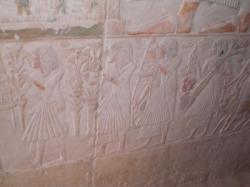
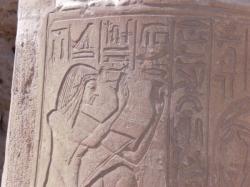 Saqqara - Tomorrow Dr. Zahi Hawass the Minister of State for Antiquities will open 7 tombs in the New Kingdom Cemetery in South Saqqara for tourism for the first time. This site contains the famous tomb of Maya, who was the treasurer of King Tut, as well as the tomb of Horemheb, the general of King Tut who later became king. Along with these two famous tombs, five other tombs will also be open to the public: The Tomb of Meryneith- Meryneith was the Steward of the Temple of Aten and the Scribe in the Temple of Aten during the reign of Akhenaten, the Tomb of Ptahemwia- Ptahemwia was the “Royal Butler, One of Clean Hands” to both Akhenaten and his son, Tutankhamen, the Tomb of Tia- Tia was one of the top officials under Ramsess II, and was the Overseer of the Treasury, the Tombs of Pay and his son, Raia- Pay was the Overseer of the Harem under King Tutankhamen.
Saqqara - Tomorrow Dr. Zahi Hawass the Minister of State for Antiquities will open 7 tombs in the New Kingdom Cemetery in South Saqqara for tourism for the first time. This site contains the famous tomb of Maya, who was the treasurer of King Tut, as well as the tomb of Horemheb, the general of King Tut who later became king. Along with these two famous tombs, five other tombs will also be open to the public: The Tomb of Meryneith- Meryneith was the Steward of the Temple of Aten and the Scribe in the Temple of Aten during the reign of Akhenaten, the Tomb of Ptahemwia- Ptahemwia was the “Royal Butler, One of Clean Hands” to both Akhenaten and his son, Tutankhamen, the Tomb of Tia- Tia was one of the top officials under Ramsess II, and was the Overseer of the Treasury, the Tombs of Pay and his son, Raia- Pay was the Overseer of the Harem under King Tutankhamen.
http://www.drhawass.com/blog/7-new-kingdom-tombs-be-opened-saqqara
- FRANCE – 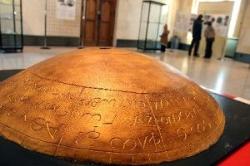 Chevroches - Les journées archéologiques ont débuté vendredi soir, au musée Romain-Rolland. Josette Sivignon, conservateur, et son équipe, ont invité une spécialiste, Aurélie Rousseau, archéologue à l'INRAP, accompagnée d'Astrid Chevolet, chargée de communication à l'INRAP. Vidéoprojection à l'appui, la conférencière a présenté le site gallo-romain de Chevroches, où des fouilles ont mis en lumière le passé du site, au plan commercial et métallurgique. La désormais célèbre Calotte de Chevroches a été découverte il y a neuf ans. Elle est constituée d'un alliage de cuivre de 64,5 mm de diamètre pour une épaisseur de 13 mm, avec trou central de 5 mm. Trois mots superposés, en Grec, sont inscrits, finement ciselés, dans chacun des douze compartiments gravés sur la calotte.
Chevroches - Les journées archéologiques ont débuté vendredi soir, au musée Romain-Rolland. Josette Sivignon, conservateur, et son équipe, ont invité une spécialiste, Aurélie Rousseau, archéologue à l'INRAP, accompagnée d'Astrid Chevolet, chargée de communication à l'INRAP. Vidéoprojection à l'appui, la conférencière a présenté le site gallo-romain de Chevroches, où des fouilles ont mis en lumière le passé du site, au plan commercial et métallurgique. La désormais célèbre Calotte de Chevroches a été découverte il y a neuf ans. Elle est constituée d'un alliage de cuivre de 64,5 mm de diamètre pour une épaisseur de 13 mm, avec trou central de 5 mm. Trois mots superposés, en Grec, sont inscrits, finement ciselés, dans chacun des douze compartiments gravés sur la calotte.
http://www.lyonne.fr/editions_locales/hautnivernais/les_mysteres_de_la_calotte_de_chevroches@CARGNjFdJSsBERgAAh0-.html
- FRANCE – Grotte du Placard - Dans le cadre des Journées nationales de l'archéologie, le Conseil général, propriétaire du site depuis 1990, a souhaité ouvrir la grotte du Placard au public tout au long de ce week-end. La visite permettait de rappeler que la grotte, datée de - 20 000 ans, fut découverte dans la seconde moitié du XIXe siècle. « Mais elle a été entièrement vidée, sans tenir compte des couches stratigraphiques. Il aura fallu attendre plus d'un siècle, exactement en 1988, pour que Louis Duport, attaché au service archéologie du Département, découvre la fameuse paroi gravée qui a rendu la grotte de Vilhonneur célèbre dans le monde entier. Des représentations d'animaux : rennes, chevaux. Mais surtout les fameux « signes du Placard » que l'on retrouve, exactement identiques dans d'autres grottes, comme celle de Lascaux. La signification de ces signes abstraits demeure encore une énigme. On parle souvent des représentations des chevaux de Lascaux, mais je trouve ces signes encore plus intéressants, en raison du fait qu'ils conservent leur part de mystère. C'est émouvant de se trouver face à l'expression de gens qui ont vécu il y a 20 000 ans.
http://www.sudouest.fr/2011/05/22/la-grotte-du-placard-devoile-ses-tresors-405366-757.php
- ROYAUME-UNI -Willingham - There is an area to the north of Willingham that is labelled Weathersome Common on the Ordnance Survey map. It is currently arable farmland, but if you had been there around three thousand years ago, you’d probably have wet feet. This is the site if Willingham Mere, long since drained, and perhaps soon to reveal some secrets. Experts from Cambridge Archaeological Unit are soon to begin excavating an area at the edge of the former mere. Previous excavations in the area between Needingworth and Haddenham have produced bones of animals that can still be found in the area, such as herons, ducks and swans, but they’ve also revealed animals that are locally extinct. Can you imagine how exciting it would be if Willingham Mere reveals more skeletal remains of beavers, white-tailed eagles or Dalmatian pelicans?
http://www.cambridge-news.co.uk/Home/Blogs/Neil-Renwicks-Wildlife-Blog/wheat-to-wet-feet-21052011.htm
- CHYPRE –  Maroni – Kalavasos - Instead of using a shovel or a trowel, Erin's Kevin Hurley will use ground-penetrating radar and magnetometer systems to explore archaeology sites in Cyprus as part of a monthlong research project. Kevin, a student at Ithaca College, will be part of a nine-member research team examining 25 acres at Maroni and Kalavasos. The sites are from the late Bronze Age (1550-1200 B.C.). The research team -- a collaboration between Ithaca College and Cornell University -- will walk the instruments across the site, taking readings every 25 centimeters or less. The equipment will allow researchers to pinpoint areas they want to look at and leave the site the way they found it. "Though a number of late Bronze Age sites on Cyprus have been partially excavated, we still have no clear picture of the anatomy of a Bronze Age city from that time," said Michael "Bodhi" Rogers, associate professor of physics and Kevin's faculty mentor.
Maroni – Kalavasos - Instead of using a shovel or a trowel, Erin's Kevin Hurley will use ground-penetrating radar and magnetometer systems to explore archaeology sites in Cyprus as part of a monthlong research project. Kevin, a student at Ithaca College, will be part of a nine-member research team examining 25 acres at Maroni and Kalavasos. The sites are from the late Bronze Age (1550-1200 B.C.). The research team -- a collaboration between Ithaca College and Cornell University -- will walk the instruments across the site, taking readings every 25 centimeters or less. The equipment will allow researchers to pinpoint areas they want to look at and leave the site the way they found it. "Though a number of late Bronze Age sites on Cyprus have been partially excavated, we still have no clear picture of the anatomy of a Bronze Age city from that time," said Michael "Bodhi" Rogers, associate professor of physics and Kevin's faculty mentor.
http://www.stargazette.com/article/20110521/LIFE12/105210322/Jennifer-Kingsley-Neighbors-Elmira-area-grad-join-archaeological-dig-Cyprus?odyssey=tab|topnews|text|FRONTPAGE
- ROYAUME-UNI – 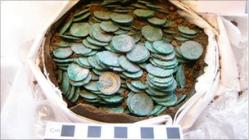
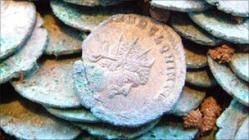 Colchester - A collection of Roman coins has been unearthed by archaeologists excavating a former barracks in Colchester. Two pots, one of them containing 1,247 coins, were discovered on the site of the former Hyderabad and Meeanee barracks, which are being redeveloped. The coins, known as antoniniani, date back to between 251 and 271 AD. Philip Crummy from the Colchester Archaeological Trust said the find would shed light on how people looked after their money in Roman times. Mr Crummy said: "What you're looking at is how somebody managed their savings, taking some out and putting some back in probably over a number of years. "It does look as if there's no difference in terms of the dates of the coins at the bottom than at the top. "In other words, the coins were probably put in the pot as one lump all at once. "There was an identical pot right next to the one that was filled with coins which was empty. "I think what happened here was it had coins in it and had been emptied and put back in the ground again in readiness for more coins." The discovery is not the first example of buried coins to have been found in the Colchester area. More than 6,000 similar coins were found in the Gosbecks area of the town in 1983 and another stash of 600 was discovered in East Mersea in 1980. Mr Crummy explained the coins were originally buried at a time of public unrest and civil war. The coins are the latest significant finds to to be unearthed at the nine-hectare (22-acre) site. In April, the bones of two Anglo-Saxon soldiers were found and in 2005 the site of a Roman chariot circus was found in the gardens of the former sergeants' mess.
Colchester - A collection of Roman coins has been unearthed by archaeologists excavating a former barracks in Colchester. Two pots, one of them containing 1,247 coins, were discovered on the site of the former Hyderabad and Meeanee barracks, which are being redeveloped. The coins, known as antoniniani, date back to between 251 and 271 AD. Philip Crummy from the Colchester Archaeological Trust said the find would shed light on how people looked after their money in Roman times. Mr Crummy said: "What you're looking at is how somebody managed their savings, taking some out and putting some back in probably over a number of years. "It does look as if there's no difference in terms of the dates of the coins at the bottom than at the top. "In other words, the coins were probably put in the pot as one lump all at once. "There was an identical pot right next to the one that was filled with coins which was empty. "I think what happened here was it had coins in it and had been emptied and put back in the ground again in readiness for more coins." The discovery is not the first example of buried coins to have been found in the Colchester area. More than 6,000 similar coins were found in the Gosbecks area of the town in 1983 and another stash of 600 was discovered in East Mersea in 1980. Mr Crummy explained the coins were originally buried at a time of public unrest and civil war. The coins are the latest significant finds to to be unearthed at the nine-hectare (22-acre) site. In April, the bones of two Anglo-Saxon soldiers were found and in 2005 the site of a Roman chariot circus was found in the gardens of the former sergeants' mess.
http://www.bbc.co.uk/news/uk-england-essex-13467666
- TURQUIE – 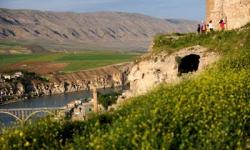 Hasankeyf - It is one of the oldest continuously inhabited settlements on Earth, a town on the banks of the Tigris that dates back to the bronze age. Over the years it has survived the rise and fall of empires, drought, war and the harsh vicissitudes of nature. But Hasankeyf is facing the prospect of being flooded out of existence as Turkish authorities seek to speed up a dam project in south-east Anatolia that will raise the level of the river by 60 metres (200ft). "Hasankeyf has housed all the civilisations of Mesopotamia," says Idris Turan, a local guide. "Romans, Byzantines, Assyrians, Arabs, Mongols and Ottomans – they have all passed through here and left their marks on the town." The remains of a medieval bridge, one of the largest of its era, still withstand the currents of the Tigris. On the northern bank stands the 15th-century Zeynel Bey mausoleum, with its kufic tiles of glazed turquoise. More than 300 historical sites lie in and around Hasankeyf, many of them unexplored.
Hasankeyf - It is one of the oldest continuously inhabited settlements on Earth, a town on the banks of the Tigris that dates back to the bronze age. Over the years it has survived the rise and fall of empires, drought, war and the harsh vicissitudes of nature. But Hasankeyf is facing the prospect of being flooded out of existence as Turkish authorities seek to speed up a dam project in south-east Anatolia that will raise the level of the river by 60 metres (200ft). "Hasankeyf has housed all the civilisations of Mesopotamia," says Idris Turan, a local guide. "Romans, Byzantines, Assyrians, Arabs, Mongols and Ottomans – they have all passed through here and left their marks on the town." The remains of a medieval bridge, one of the largest of its era, still withstand the currents of the Tigris. On the northern bank stands the 15th-century Zeynel Bey mausoleum, with its kufic tiles of glazed turquoise. More than 300 historical sites lie in and around Hasankeyf, many of them unexplored.
http://archaeologynewsnetwork.blogspot.com/2011/05/turkish-dam-threatens-bronze-age-site.html
- NOUVELLE-ZELANDE – Rangiriri - The impending construction of the Waikato expressway at Rangiriri has archaeologists digging into the Waikato's buried past – and what's been discovered is being hailed as "mind-blowing". The New Zealand Transport Agency is collaborating with Waikato Tainui in a bid to uncover and "acknowledge" the historic pa and site of the 1863 battle of Rangiriri, which straddles State Highway 1. A small test excavation two years ago showed the site could be significant and confirmed it was in good condition. For the last six weeks an archaeological team has been working under the watch of NZTA and Tainui and the results have excited those involved. It's mind-blowing," said Waikato Tainui expressway project manager Moko Tauariki. "It's also a relief in the the sense that we've always known it was here and always wanted to look at how we preserve these wahi tapu (places of cultural/spiritual significance)." Work has been sporadic over the past few weeks because of wet weather but Mr Gumbley said they had already uncovered 100 individual remains, ranging from trenches to beer bottles. It started out as a pa before being taken over by British troops during the land wars and used as a tactical redoubt.
http://www.stuff.co.nz/waikato-times/news/5035281/Pa-site-finds-stun-diggers/
- AUSTRALIE – 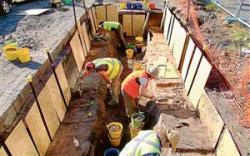
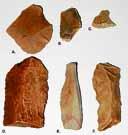

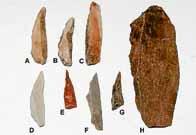 Newcastle - AUSTRALIA’S largest KFC restaurant stands above one of the country’s most significant Aboriginal heritage sites in Newcastle West, a new archaeological report has revealed. The former Palais night spot site contains carbon-dated evidence of Aboriginal occupation dating back between 6716 and 6502 years – the oldest evidence of human settlement in Newcastle. But the final excavation report, which rates the site as having ‘‘high to exceptional cultural and scientific significance’’ was only completed this month, even though the KFC building was built about a year ago. ‘‘Are we just documenting these sites so we can destroy them later?’’ University of Newcastle Coal River Working Party chairman Gionni DiGravio said yesterday. ‘‘Aboriginal archaeology is not given any importance, which I find amazing. This material is as significant as anything you would find in Europe.’’ The Hunter Street site was excavated following the demolition of the Palais in 2008. Items found at the site include more than 5700 stone tools and campsite remains. ‘‘Few open sites in the local, regional or national contexts retain a large artefactual assemblage within a well-dated chronological soil profile,’’ the report says. The Newcastle Herald has previously reported that the site also contains a treasure trove of colonial-era artefacts.
Newcastle - AUSTRALIA’S largest KFC restaurant stands above one of the country’s most significant Aboriginal heritage sites in Newcastle West, a new archaeological report has revealed. The former Palais night spot site contains carbon-dated evidence of Aboriginal occupation dating back between 6716 and 6502 years – the oldest evidence of human settlement in Newcastle. But the final excavation report, which rates the site as having ‘‘high to exceptional cultural and scientific significance’’ was only completed this month, even though the KFC building was built about a year ago. ‘‘Are we just documenting these sites so we can destroy them later?’’ University of Newcastle Coal River Working Party chairman Gionni DiGravio said yesterday. ‘‘Aboriginal archaeology is not given any importance, which I find amazing. This material is as significant as anything you would find in Europe.’’ The Hunter Street site was excavated following the demolition of the Palais in 2008. Items found at the site include more than 5700 stone tools and campsite remains. ‘‘Few open sites in the local, regional or national contexts retain a large artefactual assemblage within a well-dated chronological soil profile,’’ the report says. The Newcastle Herald has previously reported that the site also contains a treasure trove of colonial-era artefacts.
http://www.theherald.com.au/news/local/news/general/6500yearold-heritage-junked/2170119.aspx